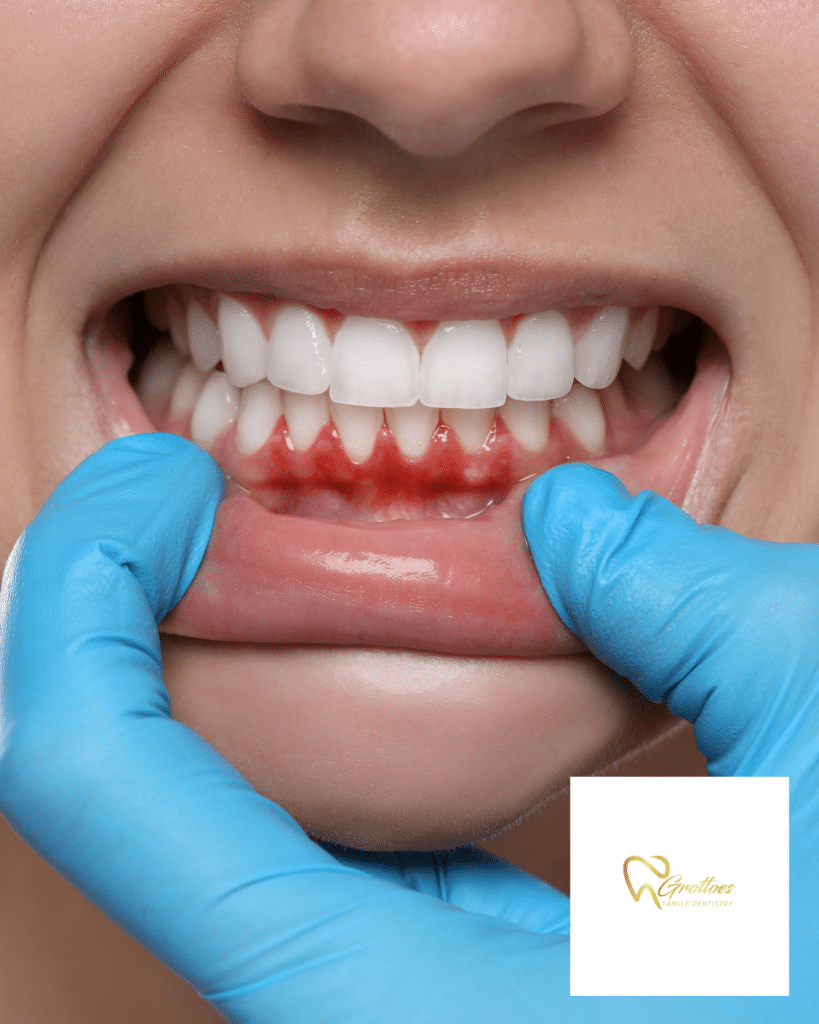
Gum disease is a common dental issue that affects millions of people, but the good news is that it’s preventable and treatable—especially when caught early. Recognizing the signs of gum disease early on can help you take the right steps to protect your smile and maintain good oral health. At Grottoes Family Dentistry, we’re here to guide you through understanding the symptoms and treatments for gum disease.
What is Gum Disease?
Gum disease, also known as gingivitis or, in its more severe form, periodontal disease, is an infection of the tissues that hold your teeth in place. It’s typically caused by poor brushing and flossing habits that allow plaque—a sticky film of bacteria—to build up on the teeth and harden. When not addressed, gum disease can lead to sore, bleeding gums, pain when chewing, bone loss, and even tooth loss.
There are two main stages of gum disease:
1. Gingivitis
This is the earliest stage of gum disease. It’s characterized by inflammation of the gums, which may cause them to become red, swollen, and bleed easily. The good news? Gingivitis is reversible with good oral hygiene and professional care.
2. Periodontitis
If gingivitis isn’t treated, it can progress to periodontitis, a more serious form of gum disease. This stage can cause the gums to pull away from the teeth, also known as gingival recession, forming pockets that become infected. Over time, periodontitis can destroy the bone that supports your teeth, leading to tooth loss.
Early Signs of Gum Disease to Watch For
Catching gum disease early makes a huge difference. Here are the most common signs that you might be developing gum disease:
1. Red, Swollen, or Tender Gums
Healthy gums should be firm and pink. If your gums are red, puffy, or sensitive to the touch, it could be a sign of gingivitis.
2. Bleeding While Brushing or Flossing
A little bleeding might seem normal, especially if you’re brushing too hard. But consistent bleeding when brushing or flossing is a major red flag for gum disease.
3. Bad Breath or a Bad Taste in Your Mouth
Persistent bad breath, even after brushing, can be a sign of bacteria buildup from gum disease. If you notice an ongoing bad taste, it’s time to get checked out.
4. Receding Gums
If your teeth start to look longer or you notice that your gums are pulling back, it could be a sign of gum recession due to periodontitis.
5. Loose or Shifting Teeth
In advanced stages of gum disease, the bone and tissue that support your teeth can weaken, causing your teeth to feel loose or shift out of place.
6. Sensitive Teeth
If you’re experiencing sensitivity to hot or cold foods and drinks, it might be due to exposed tooth roots from receding gums.
How to Treat Early Signs of Gum Disease

The sooner you address gum disease, the easier it is to treat. Here’s what you can do if you notice the early signs:
1. Improve Your Oral Hygiene Routine
The first step to fighting gum disease is maintaining a solid oral hygiene routine:
- Brush twice a day using fluoride toothpaste.
- Floss daily to remove plaque between teeth.
- Use an antibacterial mouthwash to reduce bacteria and freshen breath.
- Replace your toothbrush at least every three to four months.
2. Schedule a Professional Dental Cleaning
Even with good brushing and flossing habits, plaque can harden into tartar, which can only be removed by professional teeth cleaning. Regular cleanings at Grottoes Family Dentistry help keep your gums healthy and prevent gum disease from progressing.
3. Quit Smoking
Smoking is a major risk factor for gum disease. It weakens your immune system, making it harder to fight off infections like periodontal disease. If you smoke, quitting is one of the best things you can do for your gums—and your overall health.
4. Healthy Diet Choices
A diet rich in vitamins and minerals, especially vitamin C and calcium, supports healthy gums. Avoid sugary snacks and drinks that can contribute to plaque buildup.
5. Regular Dental Checkups
Routine dental visits are key to spotting and treating gum disease early. Dr. Dylan Hall and the team at Grottoes Family Dentistry will check for signs of gum disease during your exams and recommend the best treatment options.
Professional Treatments for Gum Disease
If your gum disease has progressed beyond the early stages, professional treatments can help manage and reverse the damage.
1. Scaling and Root Planing: This deep-cleaning procedure removes plaque and tartar from below the gumline and smooths the tooth roots, helping gums reattach to the teeth.
2. Antibiotic Treatments: In some cases, antibiotics may be prescribed to help control bacterial infection in the gums.
3. Surgical Options: For more severe cases, surgical procedures like flap surgery or bone and tissue grafts may be recommended to restore gum health and support for your teeth.
How to Prevent Gum Disease
Prevention is always better than cure! Here’s how you can keep gum disease at bay:
- Brush and floss daily.
- Visit Grottoes Family Dentistry for regular checkups and cleanings.
- Avoid tobacco products.
- Eat a balanced, nutrient-rich diet.
- Stay hydrated to maintain saliva production, which helps wash away food particles and bacteria.
Keep Your Gums Healthy with Grottoes Family Dentistry!
If you’re noticing any signs of gum disease—or if it’s just time for your regular checkup—schedule an appointment with Grottoes Family Dentistry today! Our friendly team is here to help you achieve a healthy, confident smile. Give us a call or book online to take the first step toward better gum health.
